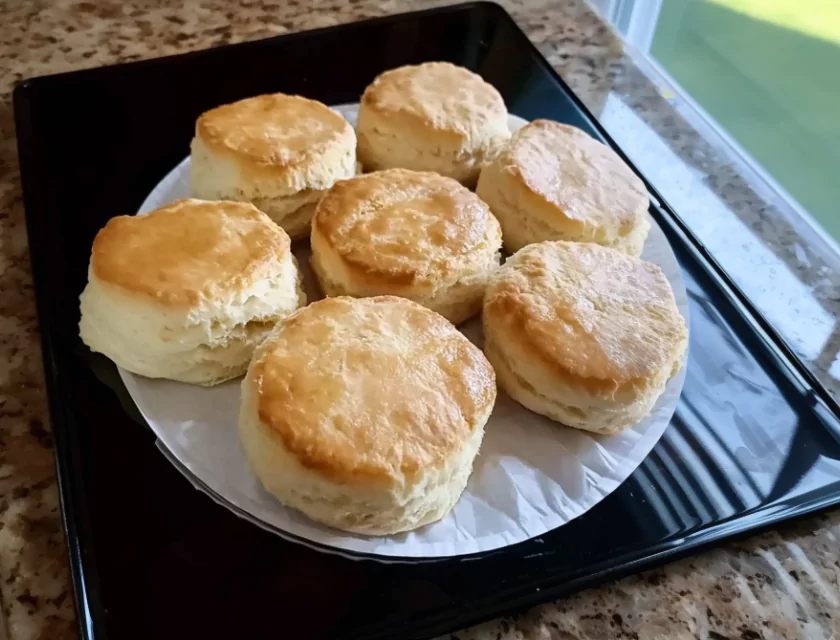Kentucky biscuits are a beloved staple of Southern cuisine, known for their flaky layers, buttery taste, and soft, tender texture. These biscuits have been a part of Southern tradition for generations, served with everything from gravy and fried chicken to jam and honey.

But what makes Kentucky biscuits different from other biscuit recipes? It all comes down to the ingredients, technique, and a little Southern charm. Unlike store-bought biscuits, homemade ones are free of preservatives and have a rich, natural flavor that complements any meal.
In this guide, you’ll learn everything about making the perfect Kentucky biscuit—from its history and cultural significance to the essential tools, ingredients, and step-by-step process of baking them at home.
A Brief History of Kentucky Biscuits
Biscuits have been a Southern staple since the early days of American history. The term “biscuit” comes from the Latin word biscoctus, meaning “twice-cooked,” though Southern biscuits differ greatly from the British hard-baked variety.
During the 1800s, biscuits became a common side dish in the South, where wheat flour was more affordable than yeast-based breads. Farmers and families needed a quick, hearty bread that could be made without yeast. Thus, the buttermilk biscuit was born.
Kentucky biscuits are unique because they emphasize flakiness and richness, thanks to cold butter and buttermilk. They became a staple in country kitchens, church potlucks, and Sunday breakfasts across Kentucky and beyond.
Preparation Phase & Tools to Use
Before diving into the recipe, having the right tools and ingredients is essential. These will help ensure your biscuits turn out soft, flaky, and perfectly golden brown.
Essential Tools and Equipment
- Mixing Bowl – A large, wide bowl allows for even mixing of dry and wet ingredients.
- Pastry Cutter (or Fork/Hands) – Helps blend butter into the flour without melting it.
- Measuring Cups & Spoons – Precise measurements are crucial for perfect biscuits.
- Rolling Pin (Optional) – Some bakers prefer to pat the dough down by hand instead.
- Biscuit Cutter or Sharp Knife – A biscuit cutter helps create uniform biscuits, while a knife works well for square biscuits.
- Baking Sheet – An ungreased baking sheet helps the biscuits rise evenly.
- Pastry Brush – For brushing melted butter on top before and after baking.
Preparation Tips for Perfect Biscuits
- Keep ingredients cold – Cold butter and buttermilk are key to a flaky texture.
- Don’t overwork the dough – Overmixing activates gluten, leading to tough biscuits.
- Use a sharp cutter – Press straight down instead of twisting to keep edges intact.
- Let biscuits touch on the pan – This helps them rise taller and bake evenly.
- Preheat the oven fully – Ensures even baking and golden-brown tops.
Ingredients List
- 2 cups all-purpose flour
- 2 ½ teaspoons baking powder
- ½ teaspoon baking soda
- 1 dash salt
- 1 tablespoon white sugar
- ½ cup cold butter (cubed or grated)
- ¾ cup buttermilk (cold)
Step-By-Step Instructions
Step 1: Preparing the Dough
- Preheat your oven to 400°F (200°C) and prepare a clean surface for kneading.
- In a large bowl, mix dry ingredients – flour, baking powder, baking soda, salt, and sugar.
- Cut in the butter using a pastry cutter or your fingers. The mixture should resemble coarse crumbs.
Step 2: Mixing the Dough
- Slowly pour in the buttermilk while stirring gently with a spoon.
- Mix until the dough just comes together – it should be slightly sticky but not wet.
Step 3: Kneading & Rolling
- Turn the dough onto a lightly floured surface and knead gently 2-3 times.
- Pat or roll the dough into a ¾-inch thick rectangle.
- Cut into squares or use a round biscuit cutter to create uniform biscuits.
Step 4: Baking to Perfection
- Place biscuits on an ungreased baking sheet, making sure they touch slightly.
- Bake for 15 minutes or until golden brown on top.
- Brush with melted butter immediately after removing from the oven.
Step 5: Serving
- Let biscuits cool for a few minutes, then serve warm with butter, honey, or gravy.
Why Buttermilk is Essential for Kentucky Biscuits
Buttermilk isn’t just about flavor—it plays a crucial role in the texture of biscuits.
- Acidic reaction – The acidity in buttermilk reacts with baking soda, creating air pockets and making biscuits light and fluffy.
- Rich flavor – Buttermilk adds a subtle tang that balances the butter’s richness.
- Moisture balance – It keeps the dough soft without making it sticky.
If you don’t have buttermilk, you can easily make a substitute:
- DIY Buttermilk Substitute: Combine ¾ cup of milk with 1 tablespoon of vinegar or lemon juice, stir, and let sit for 5 minutes.
Troubleshooting Biscuit Issues
1. Why Are My Biscuits Hard and Dense?
- Overmixed dough
- Used warm butter instead of cold butter
- Baked at too low a temperature
2. Why Didn’t My Biscuits Rise?
- Expired baking powder or baking soda
- Overworked dough
- Rolled too thin
3. How Do I Get Flaky Layers?
- Fold the dough multiple times before cutting
- Use cold butter and cold buttermilk
- Avoid pressing too hard with a rolling pin
Storing & Reheating Kentucky Biscuits
- Room Temperature: Store in an airtight container for up to 2 days.
- Refrigeration: Keeps for up to 5 days in an airtight container.
- Freezing: Wrap in plastic and freeze for up to 3 months.
Best Ways to Reheat Biscuits
- Oven: Wrap biscuits in foil and bake at 350°F for 10 minutes.
- Microwave: Wrap in a damp paper towel and heat for 30 seconds.
- Skillet: Reheat on low heat with a bit of butter.
Side Dish Recommendations
Kentucky biscuits are incredibly versatile and pair well with both savory and sweet dishes. Whether you’re serving them for breakfast, lunch, or dinner, these side dishes will complement their flaky, buttery goodness.
Savory Side Dishes
1. Classic Sausage Gravy
A rich, creamy gravy with crumbled sausage and black pepper turns biscuits into a hearty Southern breakfast.
- Cook breakfast sausage until browned.
- Stir in flour to create a roux.
- Slowly whisk in milk, simmering until thick.
- Season with salt, black pepper, and a dash of cayenne.
- Pour over warm biscuits and serve immediately.
2. Fried Chicken
Golden, crispy fried chicken pairs beautifully with soft, buttery biscuits. Serve with honey butter or hot sauce for extra flavor.
- Use buttermilk marinade to tenderize the chicken.
- Coat in a flour and spice mixture before frying.
- Fry until golden and crispy, then serve with warm biscuits.
3. Collard Greens with Bacon
A traditional Southern vegetable side that brings a deep, smoky flavor.
- Sauté onions and garlic in bacon grease.
- Add chopped collard greens and a bit of chicken broth.
- Simmer until tender and season with red pepper flakes.
4. Scrambled Eggs & Cheese
A classic breakfast combo that adds extra creaminess and protein.
- Whisk eggs with a splash of milk or heavy cream.
- Cook slowly over low heat, stirring gently.
- Add shredded cheddar or gouda for extra flavor.
5. Honey Butter & Whipped Cream Cheese
A simple but delicious topping for a quick biscuit snack.
- Mix softened butter with honey and a pinch of cinnamon.
- Whip cream cheese with a bit of powdered sugar and vanilla.
- Spread over warm biscuits for a light, sweet treat.
6. Country Ham & Red-Eye Gravy
For a true Kentucky experience, serve biscuits with salty country ham and coffee-infused red-eye gravy.
- Fry slices of country ham in a skillet.
- Deglaze with black coffee to create a tangy, smoky gravy.
- Serve over split biscuits.
7. Biscuits & Maple-Glazed Bacon
Sweet, smoky, and crispy—bacon is the perfect companion to biscuits.
- Coat thick-cut bacon with maple syrup and a sprinkle of black pepper.
- Bake until crispy, then serve alongside warm biscuits.
8. Southern-Style Mac & Cheese
For a rich and creamy side, try mac & cheese with cheddar, gouda, and parmesan.
- Make a cheese sauce with butter, flour, milk, and cheese.
- Stir in cooked pasta, then bake until bubbly.
- Serve with warm biscuits for a comforting meal.
Nutritional Information & Health Benefits
Calories and Macronutrients
One traditional Kentucky biscuit (without toppings) contains:
- Calories: ~200
- Carbohydrates: 25g
- Fat: 10g
- Protein: 4g
- Fiber: 1g
Healthier Alternatives
Whole Wheat Biscuits
- Replace 50% of the all-purpose flour with whole wheat flour.
- Increases fiber and provides a nuttier taste.
Low-Fat Biscuits
- Use Greek yogurt instead of butter for reduced fat.
- Substitute almond milk for buttermilk.
Gluten-Free Biscuits
- Use a gluten-free all-purpose flour blend.
- Add 1 teaspoon of xanthan gum for structure.
Common Mistakes & How to Avoid Them
1. Overworking the Dough
Problem: Tough biscuits
Solution: Handle the dough as little as possible—just enough to bring it together.
2. Using Warm Butter
Problem: Flat, dense biscuits
Solution: Keep butter very cold—grate it directly into the flour or freeze and cube it before mixing.
3. Baking at the Wrong Temperature
Problem: Biscuits that don’t rise properly
Solution: Always preheat your oven to 400°F (200°C) for even browning.
4. Not Using Fresh Baking Powder
Problem: Biscuits that don’t rise
Solution: Use fresh baking powder (not older than 6 months).
5. Not Letting Biscuits Touch
Problem: Short, dry biscuits
Solution: Place biscuits close together on the baking sheet—this helps them rise taller.
How to Make Biscuits Extra Flaky
- Use a folding technique – Pat the dough into a rectangle, fold it over itself, then repeat 3-4 times.
- Keep ingredients cold – Butter should be cold and solid, not softened.
- Avoid over-mixing – Stir until ingredients just come together.
Tips for Making the Best Kentucky Biscuits
Achieving the perfect biscuit texture requires the right techniques. Follow these tips to ensure flaky, buttery biscuits every time.
1. Use Very Cold Butter
- Cold butter creates flaky layers by releasing steam while baking.
- Grate frozen butter directly into the flour for even distribution.
- Chill the dough before baking for the best results.
2. Don’t Overwork the Dough
- Handle the dough gently to avoid activating gluten, which makes biscuits tough.
- Stop mixing as soon as the dough comes together—it should be slightly shaggy.
3. Fold the Dough for More Layers
- Folding the dough several times creates distinct, flaky layers.
- Roll out the dough, fold it in half, turn it 90 degrees, and repeat 3-4 times.
4. Use the Right Flour
- All-purpose flour is best for tender biscuits.
- If using self-rising flour, adjust the baking powder accordingly.
5. Don’t Twist the Cutter
- When cutting biscuits, press the cutter straight down without twisting.
- Twisting seals the edges, preventing them from rising properly.
6. Bake at the Right Temperature
- Always preheat the oven to 400°F (200°C) for proper rise and golden color.
- A hot oven ensures biscuits bake quickly and evenly.
How to Store Kentucky Biscuits
Proper storage keeps biscuits fresh and soft for longer.
1. Room Temperature Storage
- Store in an airtight container for up to 2 days.
- Place a paper towel inside the container to absorb excess moisture.
2. Refrigeration
- Refrigerate biscuits in an airtight bag for up to 5 days.
- Reheat before serving to restore their texture.
3. Freezing for Long-Term Storage
- Wrap biscuits individually in plastic wrap, then place them in a freezer bag.
- Freeze for up to 3 months.
- To reheat, bake at 350°F (175°C) for 10 minutes or until warm.
Best Ways to Reheat Biscuits
1. Oven Method (Best for Crispy Biscuits)
- Wrap biscuits in foil and bake at 350°F for 8-10 minutes.
2. Microwave Method (Quick but Softens the Biscuits)
- Wrap in a damp paper towel and heat for 30 seconds.
- This prevents biscuits from drying out.
3. Skillet Method (Adds Extra Crispiness)
- Heat a skillet over low heat and add a small amount of butter.
- Warm biscuits for 1-2 minutes per side.
Frequently Asked Questions (FAQs)
1. Can I Make Kentucky Biscuits Without Buttermilk?
Yes! If you don’t have buttermilk, you can make a quick substitute:
- Mix ¾ cup of whole milk with 1 tablespoon of vinegar or lemon juice.
- Let it sit for 5 minutes, then use it in the recipe.
2. Why Are My Biscuits Dry?
- Overbaking can dry out biscuits.
- Use cold butter and don’t skimp on buttermilk.
- Store biscuits properly to retain moisture.
3. What’s the Best Flour for Biscuits?
- All-purpose flour works well for traditional biscuits.
- Cake flour can make biscuits softer, but they may lack structure.
- Self-rising flour already contains baking powder and salt, so adjust the recipe accordingly.
4. Can I Freeze Biscuit Dough?
Yes! To freeze biscuit dough:
- Cut biscuits and place them on a baking sheet.
- Freeze until solid, then transfer to a freezer bag.
- Bake directly from frozen, adding 2-3 extra minutes to the bake time.
5. Why Didn’t My Biscuits Rise?
- Expired baking powder can prevent biscuits from rising.
- If the dough was overworked, gluten development can make biscuits tough.
- Not enough leavening or an oven that isn’t hot enough can also affect the rise.
6. How Do I Get Taller Biscuits?
- Use fresh baking powder and baking soda.
- Cut biscuits at least ¾-inch thick before baking.
- Make sure biscuits touch each other on the baking sheet—this helps them rise higher.
Final Thoughts on Kentucky Biscuits
Kentucky biscuits are a timeless Southern classic, perfect for breakfast, brunch, or dinner. Whether you serve them with gravy, honey, or jam, their flaky, buttery layers make them irresistible.
By following these simple tips and techniques, you’ll achieve perfect biscuits every time. Try experimenting with different ingredients like cheese, herbs, or even sweet fillings to create unique variations.
Now that you have all the secrets to making Kentucky biscuits, it’s time to start baking!
Print
Kentucky Biscuits
- Total Time: 25 minutes
- Yield: 12 biscuits 1x
- Diet: Vegetarian
Description
Soft, flaky, and buttery, these classic Kentucky biscuits are perfect for breakfast, brunch, or as a side dish. Made with simple ingredients and ready in just 25 minutes, they’re guaranteed to be a family favorite!
Ingredients
- 2 cups all-purpose flour
- 2 ½ teaspoons baking powder
- ½ teaspoon baking soda
- 1 dash salt
- 1 tablespoon white sugar
- ½ cup cold butter (cubed)
- ¾ cup buttermilk (cold)
Instructions
- Preheat the oven to 400°F (200°C).
- Mix dry ingredients in a large bowl—flour, baking powder, baking soda, salt, and sugar.
- Cut in cold butter using a pastry cutter or hands until the mixture resembles coarse crumbs.
- Add buttermilk slowly and mix until just combined. Do not overwork the dough.
- Turn the dough onto a floured surface and knead gently 2-3 times.
- Pat the dough into a rectangle, fold it over, and repeat 3 times to create layers.
- Roll or pat dough to ¾-inch thickness. Cut biscuits with a sharp cutter or knife.
- Place biscuits close together on an ungreased baking sheet.
- Bake for 15 minutes or until golden brown.
- Brush with melted butter immediately after removing from the oven.
Notes
- Use cold butter and buttermilk for best results.
- Avoid over-kneading to keep biscuits tender.
- Freeze unbaked biscuits for up to 3 months—bake straight from frozen.
- Prep Time: 10 minutes
- Cook Time: 15 minutes
- Category: Side Dish
- Method: Baking
- Cuisine: Southern, American
Nutrition
- Serving Size: 1 biscuit
- Calories: 200
- Sugar: 1g
- Sodium: 300mg
- Fat: 10g
- Saturated Fat: 6g
- Unsaturated Fat: 4g
- Carbohydrates: 25g
- Fiber: 1g
- Protein: 4g
- Cholesterol: 25mg


Leave a Comment